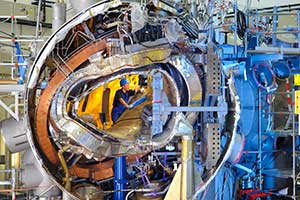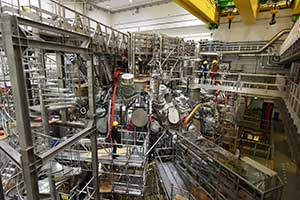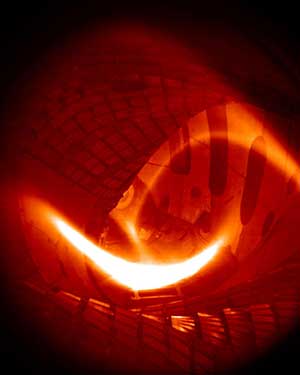Completion of the First Phase of a Major New Magnetic Fusion Experiment
Harold Weizner
The international magnetic fusion research and development program achieved a major milestone with the completion of the first phase of operation of the new W7-X stellarator facility at the Max Planck Institute for Plasma Physics in Greifswald, Germany. Almost all the magnetic fusion devices in the world confine a high temperature plasma in a torus by means of applied magnetic fields and in many cases with the addition of driven toroidal currents.
The more common tokamak confines its plasma in a nominally axisymmetric torus and magnetic field and requires substantial driven toroidal currents in order to maintain the equilibrium state. ITER, currently under construction in Cadarache, France, a major international collaboration, is a tokamak intended to operate with a net energy gain and provide the needed information to design a demonstration magnetic fusion power plant.
The stellarator design relaxes the restriction for an axisymmetric configuration and thereby can achieve plasma confinement in a torus without the need for large, driven toroidal currents. Aside from the intrinsic difficulty in driving such currents in near steady state, they also raise the possibility of generating harmful plasma instabilities. In addition to W7-X in Germany there is a close cousin of the stellarator, a heliotron, the Large Helical Device, in Japan. There are many other much smaller stellarators throughout the world. The two large experiments employ superconducting magnetic fields, and the Japanese experiment can confine a plasma for about an hour without difficulty. When one relaxes the constraint for an axisymmetric state, one finds a broad range of essentially different configurations of interest. This richness of options leads to the great diversity of experiments worldwide. With this the plethora of possibilities and the modest size of the world-wide program, international collaboration becomes a cornerstone of the work.
W7-X is the product of research stretching back to the 1950’s, especially from a major experimental and theoretical program from the 1960’s onward at the sister Max Planck Institute in Garching, Germany. Theoretical concepts and computational techniques developed there and in other parts for the world provided the basis for the “optimized” design of the facility. The design is intended to enhance the ability of the configuration to minimize plasma losses to levels comparable with those in a tokamak, such reductions being critical to ultimate reactor performance. The effectiveness of the design will be learned in continued operation of W7-X. Another goal is the study the long time behavior of confined plasmas in this configuration. The actual device is a torus of 16M across and 5M high. The mean major radius of the plasma is 5.5M, while its mean minor radius is 0.5M. The magnetic field can reach 3 Tesla and the ultimate plasma density will be about 2 × 1020 / M3. Electron cyclotron heating of 9MW should produce a temperature of up to 108 K. The efficacy of such heating was demonstrated and pioneered in work at Garching.
The experiment started operation in December 2015 with a helium plasma. At that time the goals were to certify that the device met specifications, correct any problems and validate the diagnostics. The researchers and engineers were delighted to discover that essentially all specifications were met and the facility performed as hoped and expected. In February 2016 a formal inauguration of physics research on hydrogen plasmas was celebrated, with the attendance of German Federal Chancellor Dr. Angela Merkel. In the ensuing months a broad range of experiments were performed to study the plasma performance. In these experiments approximately 40% of the researchers came from other parts of Europe and 20% from the United States, thus manifesting the essential international character of the work. To date no unpleasant surprises have arisen. The plasma typically had a density of about 3 × 1019 / M3, electron temperature of about 7 KEV, and a discharge duration time of up to 6 sec. While such parameters are not particularly noteworthy for a mature experiment, they represent a success for the facility as configured. In other laboratory plasma experiments, such performance has rarely, if ever, been achieved after only a few weeks of operation.
A major issue for all magnetic fusion machines is the maintenance of plasma cleanliness and development of means to enable plasma exhaust. These issues appear particularly complex for stellarators. In tokamaks one creates a so-called divertor on the outside of the plasma to exhaust waste and eliminate impurities. W7-X will explore the effectiveness of divertors for a stellarator. The initial configuration did not have a divertor, as one did not plan for an initial major experimental program.
A divertor is now being added to W7-X and operation will resume next year. At that time one expects much more robust performance from W7-X. It is expected that higher densities and much longer pulses and confinement times will result. In the meantime there is an active program underway to analyze the data obtained during the initial phases of the operation. One will be able to learn much about transport and plasma dynamics from this phase of operation.
The longer term plans for W7-X include very long pulse operation at high densities and temperatures, with, one hopes and expects from theoretical considerations, long confinement times. Success in this ambitious project will make the stellarator a serious contender for a demonstration fusion reactor, which is intended to follow burning plasma studies on ITER. The future success of the stellarator project will depend heavily on continued international collaboration.

Credit: Wolfgang Filser
Exterior of W7-X under construction

Credit: IPP
Exterior W7-X as completed

Credit: IPP
Plasma in W7-X
Harold Weizner is Professor of Mathematics Emeritus at the Courant Institute of Mathematical Sciences, New York University
